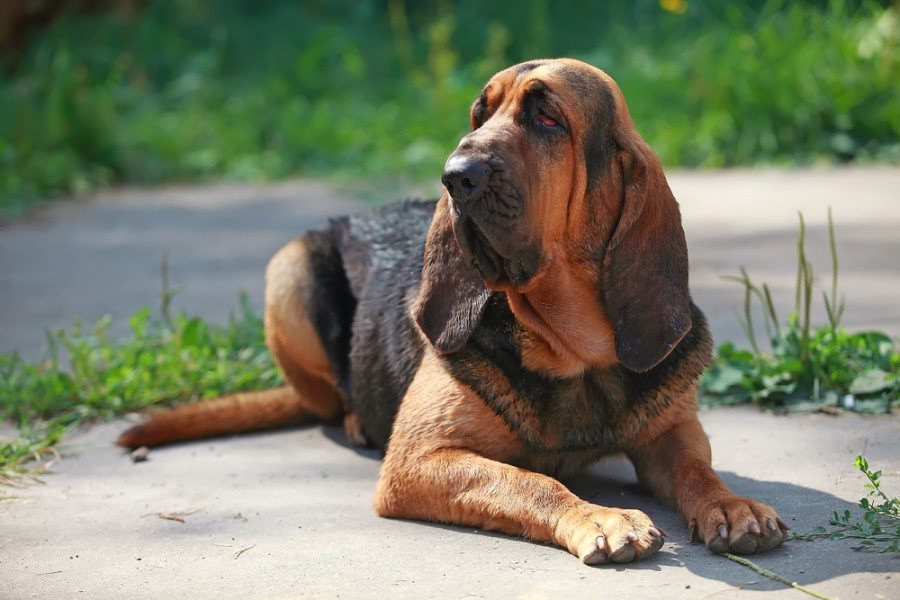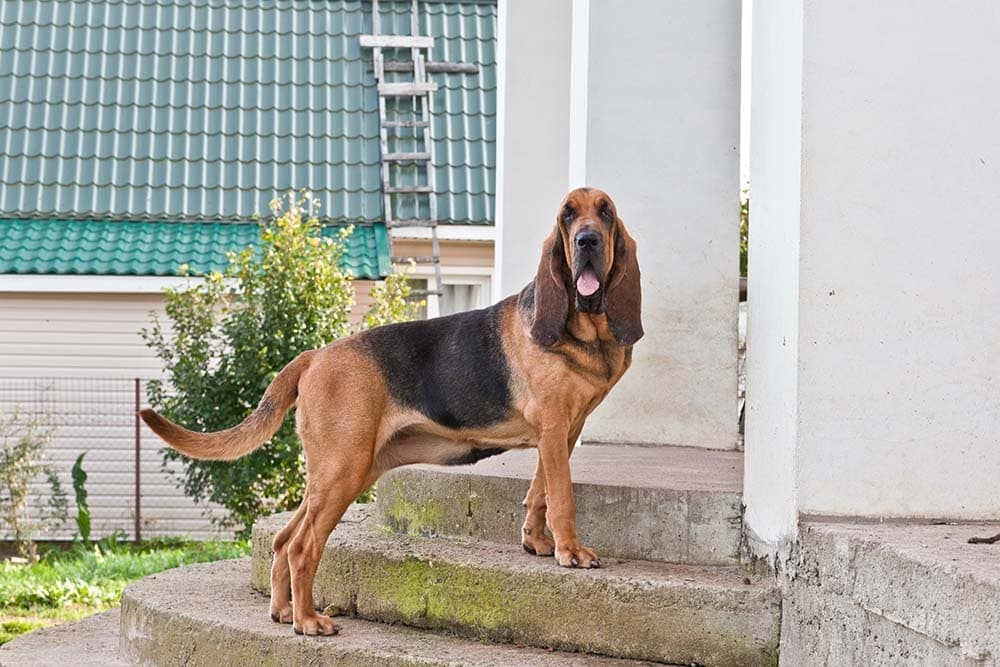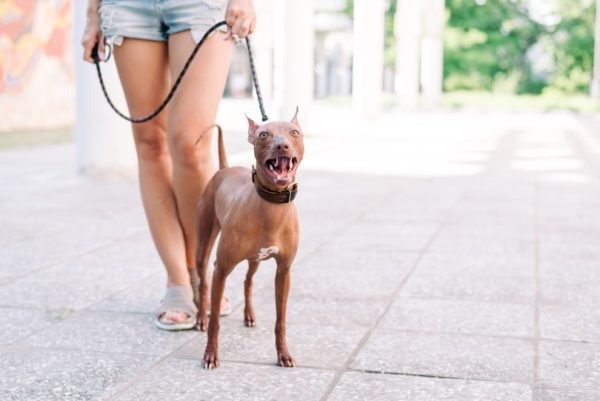In this article
View 3 More +Both the Basset Hound and the Bloodhound are known for being great hunting dogs, as well as being great at scent work. They are quite similar, obvious by their names and looks.
However, there are quite a few big differences between the two breeds. For example, the Bloodhound is quite a bit bigger than the Basset Hound. The visual differences aren’t the only way these two breeds are different, though.
Their temperament is similar to each other at first, seeing that they are both very stubborn when it comes to training, but they can behave quite differently. Let’s look at these two breeds in more detail.

Visual Differences

At a Glance
- Average Height (adult): 11–15 inches (Male); 10–13 inches (Female)
- Average Weight (adult): 50–65 pounds (Male); 40–60 pounds (Female)
- Lifespan: 12–13 years
- Exercise: Around 1 hour daily
- Grooming Needs: Near-daily brushing and cleaning
- Family-friendly: Yes
- Other pet-friendly: Yes
- Trainability: Stubborn, independent, generally hard to train
- Average Height (adult): 25–27 inches (Male); 23–25 inches (Female)
- Average Weight (adult): 90–110 pounds (Male), 80–110 pounds (Female)
- Lifespan: 10–12 years
- Exercise: 2 hours a day minimum
- Grooming Needs: Weekly brush, daily cleaning
- Family-friendly: Yes
- Other pet-friendly: Yes
- Trainability: Independent, stubborn, energetic
Basset Hound

Exercise
Generally, these dogs don’t need much exercise. They require maybe a walk a day, or just some outside playtime, but they are couch potatoes most of the time. They are very laid back and just like spending time napping or cuddling. However, they were bred to have great endurance. These dogs can keep a pace for a very long time, though they’d likely just prefer laying down for a nap.
These dogs may be pretty much couch potatoes, but they still need around one hour of exercise daily along with mental stimulation. They tend to grow very bored when going without this, and that can be troublesome. While they’d be okay with just lounging around constantly, it’s still important to get that exercise in, as they can get obese without it.
Grooming
These small dogs, while they do shed a lot, do not need a professional groomer. They shed quite a bit, and to cut down on shedding, you should really brush them once a day. If you can’t do that, every other day will be fine.
Alongside the brushing, you need to give them frequent baths as they are prone to skin infections. They also require to have their ears cleaned about every week, or twice a week, to avoid infection of the ear. You should also keep up to date with their nail clippings and dental hygiene, just to be safe and make sure your Basset Hound is properly taken care of.

Training
Basset Hounds are quite intelligent, though extremely stubborn. They enjoy hunting and tracking but they do need regular training and positive reinforcement. Training is preferably started at a young age, alongside lots of positive reinforcement to keep them interested.
They require a skilled trainer and a heavy hand in order to be properly trained. They are very independent and tend to just do their own thing, especially if they have a scent to track.
In order to train your Basset Hound, it’s going to take a lot of understanding of what motivation helps the breed most. They also need to learn behaviors through good leadership and repetition.
Temperament
Basset Hounds are very easy-going and friendly dogs, being people-oriented and child-friendly. Back at the start of the breed, they hunted in packs, making them very social creatures. They are very calm and will tolerate small children easily, making them ideal for families large or small.
They do tend to get separation anxiety when left alone for too long, so be sure to remember this when you leave for extended periods of time. They live best with people that are home a lot because they do not like being separated from their “pack” for a long time.

Suitable For:
Basset Hounds were originally bred as hunting dogs and scent-working dogs. They are perfect for someone that enjoys the idea of taking a dog out hunting for small or big game, as they are amazing trackers.
They also are great for just family life. They are tolerant and friendly, falling in love with their new family easily. They are best for active families that enjoy outside time and walks, as that’s best for the health of a Basset Hound. They also need someone that can be consistent with boundaries to ensure they do not cause trouble in the family.
They also require someone to be in charge of their food, as Basset Hounds tend to get overweight due to overeating.

Bloodhound

Exercise
Bloodhounds, being fairly energetic dogs, need to exercise at least 2 hours every day. This means play time, outside time, and walks. This exercise time should be split up, not all done in one go. They do best when there are multiple walks in the day, and they also love to be off-leash and outside to run by themselves or alongside other dogs.
Bloodhounds are known for being able to walk or jog for a very long time. After all, they are known for being able to follow a scent trail for more than 130 miles! Keeping them on a leash or a fenced-in yard is important, as they can get very distracted by a scent and end up very far away if you’re not careful.
Grooming
Bloodhounds are fairly well known for their wrinkles, but this can be a problem as bacteria and dirt can get caught in them, causing their skin to be irritated and possibly get infected. Cleaning the wrinkles daily is a good idea to ensure your Bloodhound’s health and well-being. Simply wipe the inside of the wrinkles with a damp washcloth to get rid of the dirt and bacteria within it. As well as cleaning the wrinkles on their body, be sure to wash the wrinkles around their mouth so that they don’t get food caught in them.
They do not need to be brushed often, as they have a very short but dense coat. They should be brushed weekly, if not more often. You need to be gentle when brushing your Bloodhound as they can be very sensitive skin due to their loose, thin skin. They also shed quite a bit seasonally, so be on the lookout for that.
Be sure to keep up to date on their nail clippings and their dental hygiene, the same as any dog.

Training
Bloodhounds are extremely stubborn and independent, meaning even the most skilled trainers may have difficulty if they have never trained a Bloodhound before. Be sure to set reasonable boundaries with them, and make sure to be consistent. Consistency is key when training your Bloodhound, as it is with any dog that is being trained.
It’s recommended that you start the training at a young age to really get the consistency and behavior down. Special treats and toys can be great for positive reinforcement, as they are very sensitive and often react poorly to negative reinforcement.
These dogs have quite a few behaviors that may need to be corrected in training. For example, they are extreme chewers and will chew just about anything they can get their paws on. Getting rid of this habit will require patience and time. They are also known for barking loudly and very often. This behavior, however, won’t go away easily. That means that they are best for families that live far away from neighbors to ensure they don’t get a noise complaint due to their Bloodhound.
Temperament
Bloodhounds were bred for companionship and hunting in a pack. They do very well with other dogs and children. They are very loving to their family, being perfect dogs for active families. They are also known for being very gentle, perfect for young ones.
They do, however, get sad when left alone for too long. This is because they aren’t getting their exercise needs met, but also because they will miss their family if they are left alone for a while.

Suitable For:
Bloodhounds will thrive in an active family environment with places to roam outside. This means a big backyard and frequent walks. They are extremely tolerant, which is perfect for a family with younger children.
We absolutely do not recommend a Bloodhound for a single working person, or apartments. The former is due to Bloodhounds getting separation anxiety very easily, but the latter is due to them needing a big space to live in. This is due to their size, as well as their exercise needs.

Which Breed Is Right for You?

Choosing between a Basset Hound or Bloodhound may seem like a hard decision. However, it depends mostly on your preferences and lifestyle. Bloodhounds are much larger, for instance. They can weigh up to 80 pounds.
Both breeds have similar temperaments because they are both hounds. However, Bloodhounds may be more nose-driven and have a better sense of smell. On the other hand, Basset Hounds are more food-motivated (they’re very prone to obesity, for this reason).
In the end, it may simply boil down to whether you want a large or small dog.
- Related Read: Bloodhound vs Coonhound: The Differences (With Pictures)
Featured Image Credit: (T) Bill Anastasiou, Shutterstock | (B) Degtyaryov Andrey, Shutterstock


















